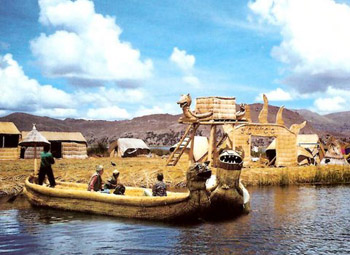
Puno, Peru
by Irene Butler
Lake Titicaca is a name all school kids know and giggle at, although most have no idea where it is – straddling as it does the border of Peru and Bolivia. Coming over a rise, our first view of its sapphire waters is stunning – 170 km in length, it looks more like an ocean than a lake. Having traveled through Peru for three weeks in November and December, my husband Rick and I decide on spending the Christmas season here.
As our bus enters the lake shore city of Puno, the magical sounds of flutes, drums and bells float across the air. Craning our necks out of the window, we see elaborately costumed dancers twirling to the rhythm of the music. “Puno is the festival capital of Peru!” says our bus driver. “The whole town participates in more than 300 a year.” Hoisted above the heads of four carriers a gigantic wooden babe in a crib conveys the message of this joyous celebration.
After stowing our bags at our hotel we join the lively crowds along the street. We purchase alpaca toques with ear flaps for the folks back home, snack on ceviche (a Peruvian specialty of raw fish marinated in spiced lemon juice) and book a Lake Titicaca Island excursion.
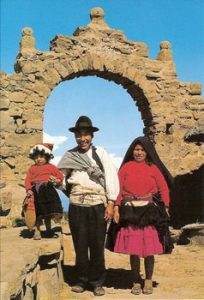 Lake Titicaca, the world’s highest navigable lake (at 3820 meters) competes with the sky for the deepest shade of blue under a brilliant sun. We skim over the glassy surface towards the Uros floating islands. “Step carefully and watch for soft spots,” our guide Juan says. I warily step onto the damp spongy surface of totora or reeds, then relax as I catch sight of children running effortlessly toward us and women going about their daily chores. Most of the men are out fishing or trapping waterfowl.
Lake Titicaca, the world’s highest navigable lake (at 3820 meters) competes with the sky for the deepest shade of blue under a brilliant sun. We skim over the glassy surface towards the Uros floating islands. “Step carefully and watch for soft spots,” our guide Juan says. I warily step onto the damp spongy surface of totora or reeds, then relax as I catch sight of children running effortlessly toward us and women going about their daily chores. Most of the men are out fishing or trapping waterfowl.
Everything is made of reeds – houses, furniture, and Viking-like dragon head boats. We test out a reed bench while the village leader demonstrates how the island’s base is built. Huge blocks of buoyant roots are harvested from the lake bottom. Once secured together and anchored, they are piled with criss-crossed layers of cut reeds until the surface is out of the water and sturdy enough to support community life.
Juan explains the “why” of this water-world: “The Uros people took refuge here to escape Inca domination, and later to avoid Spanish slave labour in silver mines.”
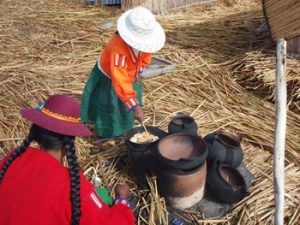 The aroma of frying bread wafts from an iron pan set over a small fire – we are captivated when the women sing a carol while offering us the warm brown rounds “as a Christmas gift” Juan says smiling.
The aroma of frying bread wafts from an iron pan set over a small fire – we are captivated when the women sing a carol while offering us the warm brown rounds “as a Christmas gift” Juan says smiling.
Another two hours brings us to Taquile Island. The inhabitants speak Quechua, the ancient Inca language, and hold strongly to traditional ways of life. Listen up fellows – the men do the knitting here, and are renowned knitters at that, learning the trade from early boyhood.
Half the island is rock; the fertile remainder is terraced for growing crops. Goats and chickens provide cheese, milk and eggs, and although the occupants are mainly vegetarian, they enjoy fresh catches of fish. We are served a divine quinoa soup and omelette in a private home before heading back in a sudden afternoon squall that whips the lake into frothy grey foam.
After wishing our family back home in Canada “Feliz Navidad” by phone, we walk to a small colonial church for Christmas Eve mass. We didn’t need to understand the language to be uplifted by the choir and the brightly decorated altar.
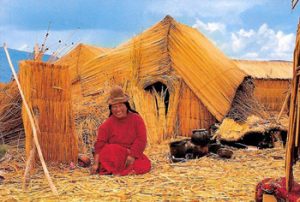 Roco, our hotel manager, and his wife Maria invite us to share their Christmas Day supper. Knowing the fare might well be guinea pig, eaten widely in Peru, we don our “try anything once” attitude.
Roco, our hotel manager, and his wife Maria invite us to share their Christmas Day supper. Knowing the fare might well be guinea pig, eaten widely in Peru, we don our “try anything once” attitude.
A feast awaits as we join a dozen or so guests. And yes, one of the many courses is Cavia Porcellus, which tastes rather like chicken, although there was no mistaking its form. Alpaca, roasted Inca style, is served to table on flat hot rocks just lifted from an open wood fire. The fireplace is then stoked for an evening of camaraderie while we sip fine wine.
It was an enlightening experience being so far removed from our country of plenty, and in the midst of a simpler, less affluent world. The differences of customs and traditions dissolved in the universal message of love, peace and good will as shown us by our Peruvian hosts. Truly an unforgettable Yuletide celebration.
For Further Information:
Peru Information
Puno Hotels
Puno Travel Agency – Edgar Adventures
Plaza Mayor Hotel, Puno
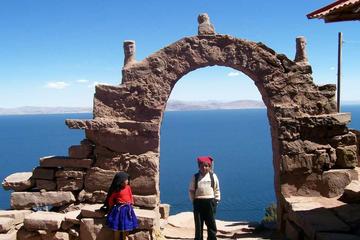
Full Day Tour: Uros and Taquile Islands on the Titicaca Lake from Puno
About the author:
Irene Butler and her husband Rick are a travel journalist/photographer team from Richmond, B.C. They lead a gypsy existence travelling around the world for six months of each year – their tally is 53 countries visited to date.
www.globaltrekkers.ca
Photo Credits:
Reed House and Frying Bread by Mick Linthorne. Woman Sitting, Boat and Taquile Island by Rick Butler


